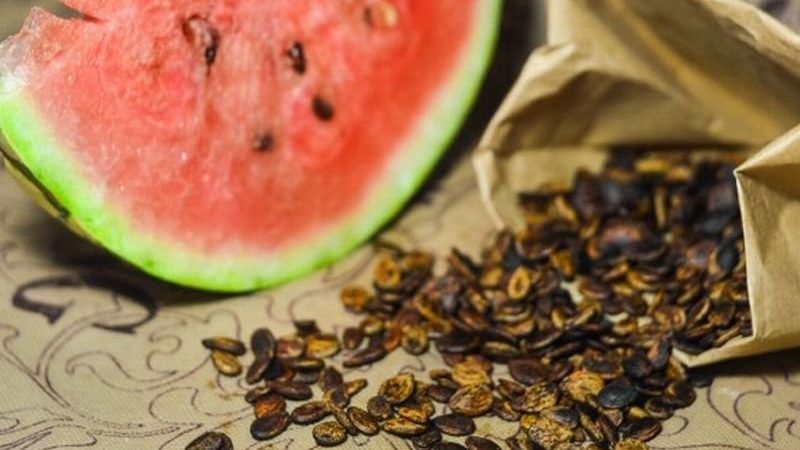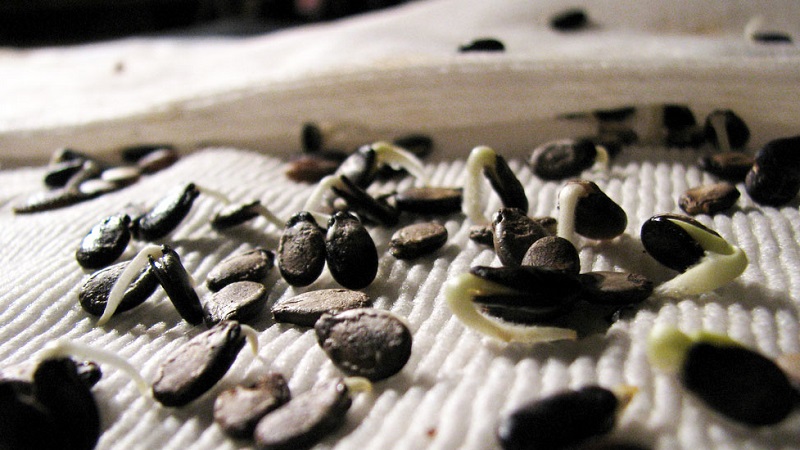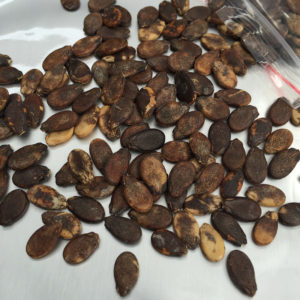How to store watermelon seeds for home planting
For the purity of the variety, many summer residents prefer to collect seed from watermelons grown on their plots. So you can immediately see which plant did not hurt, how it developed and grew. Farmers select the healthiest large fruits, the seeds of which will yield a decent harvest next season. How to collect and save watermelon seeds for planting - read the article.
The content of the article
How and when to harvest watermelon seeds
To collect seeds for storage at home, choose the most ripe watermelon on the melon. Even at the stage of ovary formation, the strongest and healthiest plant is noted, leaving 1-2 fruits on it. Extra shoots are cut off, this will allow the remaining watermelons to grow to their maximum size and form full-fledged seeds.
To avoid mixing varieties, artificial pollination is used. To do this, the pollen from the plucked male flower is transferred to the pistil of the female, after which the pollinated flower is isolated from pollen from other plants.
The full ripeness of a watermelon is determined by the drying of the stalk, antennae, leaves on the branch. The main sign of maturity is considered to be a dull sound when tapping on the fruit, a characteristic crackle when pressed. The peel of a ripe watermelon looks evenly shiny, a yellow spot appears at the point of contact with the ground. To prevent decay in this place, a plank is placed under the stain. A watermelon that has reached full ripeness stops growing, acquiring the maximum size for the selected variety.

Early varieties reach biological ripeness 35-40 days from the beginning of ovary formation, middle and late varieties - 40-50 days. Gourds are harvested at the end of August.
Attention! Varieties with early ripening periods are best suited for sowing, since there is a chance that they will have time to ripen before the onset of cold weather.
If it is not possible to grow a watermelon within these periods, it is put to ripening in a cool room for three weeks. At the same time, the quality of the seed material does not change; in some cases, the number of mature seeds even increases.
Overripe, soft fruits are not suitable for the selection of seed. Inside such watermelons sometimes begin germinate seeds... Accordingly, seeds from overripe fruits have low germination and weak germination energy.
Reference! Pits selected from hybrid fruits are not suitable for growing. The crop from such seeds will not match the characteristics of the parent hybrid.
When choosing a watermelon, make sure the fruit has not been cross-pollinated by insects with other crops growing in adjacent beds.
Melon seeds harvested in dry warm summers are stored much better and longer than grown in wet and cool seasons.
Seed collection algorithm at home
The most complete fruitful seeds are located in the sugar part of the fruit. But other ripe seeds are also extracted, they differ insignificantly in quality, so you should not discard them.
Cut the watermelon in half, separate the ripe pulp along with the seeds, put it in a non-metallic container (so that the oxidation process does not start). The pulp with seeds is poured with water and kept for three days, causing fermentation. Then the water is drained, the seeds are washed several times in running water to remove the pulp.Unremoved fibers will begin to degrade, leading to the unwanted formation of pathogenic bacteria and fungi.
Another option: the watermelon is eaten, the seeds are collected in a container, water is poured with the addition of a drop of dish detergent, mixed thoroughly to remove sugar. Then it is poured onto a sieve, washed with running water, laid out to dry.

Selection of seeds
After drying, the seed is calibrated... For storage, large specimens of approximately the same size are chosen in order to further achieve simultaneous germination.
Small, unpainted, deformed, with a damaged surface are laid, they are not useful for growing large fruits. They are planted separately, they will also grow, but the fruits will be medium in size.
When choosing, they prefer black and dark brown seeds of a dense consistency. Unripe white seeds are unsuitable for sowing, they are thrown away.
Suitable seed criteria
Before preparing for storage, the seeds are first checked for viability. For this, the selected material is placed in a deep container and poured with clean water for half an hour. The emerged specimens are empty and unsuitable for further cultivation, they are discarded. The seeds lying at the bottom of the container are removed from the water, dried for three days and prepared for long-term storage.
How to process the resulting seed

Each melon seed is surrounded by a gelatinous shell, which is removed by fermentation (a procedure reminiscent of the natural decay of plant fibers). To do this, they cause the fermentation process: the pulp with seeds is poured with a small amount of water, kept for three days.
When the mixture begins to ferment and traces of gray mold appear on the surface, this indicates decomposition of the oily shell on the seeds. When air bubbles form, the fermentation process is stopped. Water is added to the fermented mixture and mixed thoroughly, helping these seeds to clear the decomposed film. Then the water is drained, after which the seed is washed several times in running water for final cleaning. After that, the seeds are taken out and dried on a plate.
For better keeping quality, the harvested seeds are treated with "Fentiuram" - a chemical dressing agent for disinfection and protection against damage by pathogenic fungi and bacteria. The drug is diluted in water according to the instructions, a solution is prepared at the rate of 3 g of the agent per 1 kg of seed and the seeds are soaked in it for 20-30 minutes.
After etching, the bones are laid out in one layer on paper or cloth and left to lie until they dry completely... The stuck together specimens are separated. It is better not to use thin paper napkins, as their fibers stick to the damp surface of the bones. With prolonged storage in these places, there is a possibility of the appearance of pathogenic bacteria.
Important! Damp seeds mixed with debris quickly heat up, mold and rot.
For drying, use plastic nets with small cells. In them, the seed material is well ventilated and dries evenly from all sides. Sun drying is not recommended. At room temperature 20-25 ° C, the seeds will dry out within two days.
How to store
After complete drying, the seed is placed in a paper bag, which indicates the variety and the date of harvest.
With proper storage, melon seeds remain viable for several years and have good germination energy. But some farmers are faced with the fact that the sown seeds do not germinate. The main reason is unfavorable conditions and improper storage.
Several factors affect the storage of planting material. These include:
- Temperature. The lower the temperature in the room, the longer the seeds do not lose their germination. Warm storage conditions lead to rapid oxidation of nutrients and damage to seeds.The optimum storage temperature is within + 10-15 ° C.
- Humidity. With high humidity in the room, mold appears on the bones. Moisture contributes to unwanted premature germination. The seeds can rot under these conditions. Therefore, well-dried seeds are deposited for storage. The optimum humidity is maintained at 40%.
- Air circulation. The room is regularly ventilated. Stagnant air will lead to the appearance of pathogenic microbes.
- Sterility. No debris must enter the seed. This will lead to damage to the seeds, pests that feed on the seeds will appear.
- Lighting. The lack of sunlight prevents the seeds from germinating. They are stored in complete darkness until sowing.
Read also:
How to water watermelons outdoors: watering frequency and rules.
Optimal storage conditions and periods

Melon seeds are stored in an open and closed way.
With the open method, the seed is placed in bags made of natural (linen) fabrics that allow air to pass through well.
In a closed storage method, the seeds are placed in paper bags and placed in a plastic container. A layer of table salt or flour is poured at the bottom of the container to absorb excess moisture, close the container with a lid.
Experienced farmers prefer the first storage method.
Seeds cannot be stored in plastic bags or foil, they will quickly suffocate and die.
Important! The best germination is shown by seeds aged after harvest for 2-3 years. Annual seed germinates longer and gives low yield rates.
The seeds retain their high varietal and sowing properties for five years. After 6-8 years of storage, these qualities decrease.
Conclusion
Farmers have learned from their own experience that getting seed material is better on their plots than buying in stores. In quality, it is significantly superior to the purchased one. A high-quality crop with the exact characteristics of the variety (but not a hybrid) is obtained from the material collected with his own hand. It is much more economical than purchasing seeds from garden centers.